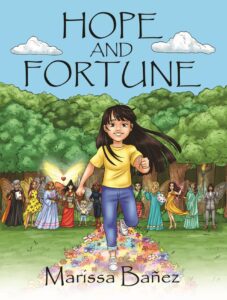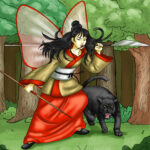 Children’s book author Marissa Bañez helps me kick off a new week talking about her new children’s illustrated book, Hope and Fortune.
Children’s book author Marissa Bañez helps me kick off a new week talking about her new children’s illustrated book, Hope and Fortune.
Bio:
A first-generation immigrant to the U.S. from Baguio City, Philippines, Marissa Bañez is a graduate of Princeton University (B.A. in politics and a teaching certificate) and a lawyer licensed to practice in New York, California, and New Jersey. She has published legal articles for the prestigious New York Law Journal and the American Bar Association, but her true passion for writing is her children’s stories. At almost age 65, she is embarking on her new venture as a children’s illustrated book author with the debut of Hope and Fortune. Her second book, Hues and Harmony (How the Rainbow Butterfly Got Her Colors) is scheduled for publication on July 20, 2023.
Welcome, Marissa. What do you enjoy most about writing children’s stories?
The primary reason I like writing children’s illustrated books is because it enables me to connect with readers who are still full of wonder, wide-eyed innocence and, hopefully, an eagerness to learn without cynicism or preconceived notions.
Can you give us a little insight into a few of your stories – perhaps some of your favorites?
All of my children’s illustrated books are meant not only to entertain but also to teach. They are written to be more than meets the eye.
For example, I wrote Hope and Fortune to be a multi-layered story. At face value, it’s a modern-day fairy tale in which a child named Esperanza finds herself in a scary situation. Twelve fairies give her life advice and then show her the way to safety and security.
But in reality, Esperanza is merely the conduit through which the fairies are introduced. My intention was to inject and immerse the reader directly into the story as the true recipient of the fairies’ messages, which is why Esperanza vanishes and is literally out of the picture when the fairies speak. I purposely kept her out of sight until the end when she acknowledged the fairies’ gifts to her because including her in the fairies’ illustrations would break the fairy-reader connection I wanted to establish. In fact, many young and not-so-young readers have told me how they felt personally touched by some of the fairies’ messages as they related them to their own experiences. That’s also why most reviewers comment on why Hope and Fortune should be read by adults for themselves and not just for their children. Even the manner in which Esperanza thanked the fairies at the end is deliberately written in the way that I wanted the reader to remember the fairies’ messages. In short, most of the book isn’t for — or even about — Esperanza at all.
What genre are you inspired to write in the most? Why?
Writing in the children’s illustrated books space is inspiring to me because apart from giving me the opportunity to connect with young people, the word-count limitation provides a challenge for me to express my messages and thoughts in a succinct but still meaningful and accurate way.
And because the books are illustrated, I have the freedom to supplement my text with illustrations curated and drawn to provide greater depth and substance to my stories.
As I said above, Hope and Fortune is a multi-dimensional story. Beyond the basic story line, I wanted to introduce certain concepts in a subtle way. First, to introduce diversity, I sketched the characters to be multiracial, multicultural, mutigender, and multigenerational and of different sizes and shapes. Then, I chose colors, numbers and specific animals that symbolize certain ideals that dovetail into my story’s messages. For instance, in spiritual traditions of some cultures, people use animals to represent kindred spirits to guide or protect them through their life journeys. The spirit animals I use in Hope and Fortune personify the views and ideals of their respective fairies.
 The Fortune Fairy of Strength and Courage is an example. To me, female Asian warriors are the epitome of strength and courage. Red is traditionally associated with the idea of courage. As a symbol of protection and agility, the black cougar (her spirit animal) represents a fierce protector, just like the fairy.
The Fortune Fairy of Strength and Courage is an example. To me, female Asian warriors are the epitome of strength and courage. Red is traditionally associated with the idea of courage. As a symbol of protection and agility, the black cougar (her spirit animal) represents a fierce protector, just like the fairy.
(As an aside, please visit https://www.marissabanez.com/books/hopeandfortune for the page in my website that discusses the various concepts and references underlying each of my illustrations.)
What exciting story are you working on next?
Like Hope and Fortune, my next book, Hues and Harmony (How the Rainbow Butterfly Got Her Colors), teaches life lessons in a fun and entertaining way, using common shapes, primary colors and basic chemistry concepts, with a singing gray caterpillar as the main character. On another level, it’s a story about multiraciality, self-discovery, self-acceptance and empowerment as told through the life and adventures of the caterpillar who felt different and who eventually becomes a colorful butterfly with a very special message. The main characters of Hope and Fortune make a cameo – but critical – appearance in Hues and Harmony but it’s not a sequel.
 When did you first consider yourself a writer?
When did you first consider yourself a writer?
My husband was 49 and I was 40 when we got married. As we were both no-longer-young, I did not expect to have a child. Yet, one night during our honeymoon, I had a wonderful, extremely vivid dream. I still remember every detail to this day. In the dream, I found myself in a beautiful, very colorful floral garden, feeling peaceful and happy. Suddenly, singing, laughing, and dancing angels and cherubim surrounded and enveloped me into their midst, giving me a joyful and warm feeling beyond all imagination. Then, a dark-haired cherub kissed me on the lips. I immediately woke up and, still very much feeling the cherub’s kiss on my lips, told my husband that we were going to have a baby. Nine months later, my daughter Angelica was born.
For no particular reason, I wrote a little book about that dream. Whenever I read the story to my friends, everyone always got a bit teary-eyed in a good way, which led me to think that I might be able to write stories that affect people positively.
When my daughter was a little girl, I wrote other original children’s stories for her and her friends and created puppet shows out of the stories. I had fun, the kids had fun, so why not keep doing it?
For her 7th birthday party, my daughter wanted a story about cowgirls, fairies, and her little stuffed horse. I came up with a story entitled, The Lost Foal, in which the stuffed horse got lost in the forest and encountered “cowgirl fairies” played by my daughter and her guests. Fast forward 16 years later to the pandemic and lockdown in 2020. I felt bad for my daughter, her peers and those younger, all of whom faced unprecedented uncertainties in life. I then took The Lost Foal, modernized it with a diverse cast of characters, and created a message that I hope will resonate not only with the very young but also with those less so who may feel rudderless and lost (in however way you want to define and contextualize those terms) at some point in their lives.
How do you research markets for your work, perhaps as some advice for writers?
There’s no magic formula. I simply take advantage of every single opportunity to talk about my book to family, friends, colleagues, acquaintances, and, yes, even strangers. Thankfully, my genre has a huge market because most people have children in their lives in one form or another, and those that aren’t relatives of children may have a reason to gift books to others’ children. So, I’m always selling to anyone and everyone I come across. Sometimes, an opportunity comes up where I decide to give a book to someone to create a certain amount of goodwill in the hopes that that person might talk up the book to others.
I also spend hours and hours in front of the computer. The internet has a wealth of information that’s easily accessible. Sifting through all of it to figure out what might work for me and then following up – with emails, snail mail submissions, telephone calls, and in-person visits to brick-and-mortar stores – is what takes up a lot of time and energy. Still, my efforts have resulted in TV and other on-camera appearances, several articles written about me and my book in traditional printed media, and social media exposure through blogs and other platforms. I’ve written a couple of guest blog posts on marketing that might be of some assistance to other writers:
http://www.mindymcginnis.com/blog/banez
https://www.astorybookworld.com/2023/02/guest-post-getting-your-tribes-to-help.html
What would you say is your interesting writing quirk?
For some reason, whenever I sit down to write my children’s stories, all of the dialogue comes out in rhyme in my head. The narration of the story line is never in rhyme. I’ve tried writing dialogue without rhyming but it doesn’t work and it’s nowhere as fun or challenging.
As a child, what did you want to be when you grew up?
I remember one of my sisters and I were watching a Miss Universe pageant sometime in the early 1970s and the contestant from Japan (if I remember correctly) said that she was or wanted to be a lawyer. An Asian woman at that time said she was going to be a lawyer? Mind blown! I recall my sister saying then that she too was going to be a lawyer. Lo and behold, not only did she become a lawyer, she went on to become an administrative judge for the State of California. I simply followed in her footsteps and went into law as well. For me, it worked out better than okay for the last 40 years as I moved from one good position to a better one in my career as a lawyer. And, thankfully, my long legal career has given me the freedom and opportunity to now launch my Third Act (the First Act being a lawyer and the Second Act being a middle-aged mom).
Anything additional you want to share with the readers?
I want to share the most heartwarming incident connected with Hope and Fortune, which I hope will inspire others to begin (or continue) writing stories.
I recently read Hope and Fortune at a public library. After the reading, a 7-year-old Asian boy took a copy to read to himself, and then told me how much he loved the book and that now he wants to write a book someday too. Even though the book is about a little girl with a Spanish-sounding name and fairies, it still resonated with a little Asian boy – which is more than I could’ve hoped for when I created that fantastical multicultural and multiracial fairy world. How wonderful to be able to touch the hearts and minds of young children with just a few words and illustrations.
Purchase a copy of Hope and Fortune on Amazon, Barnes and Noble, and Bookshop.org. You can also add this to your Goodreads reading list. Find her on Facebook and LinkedIn.
